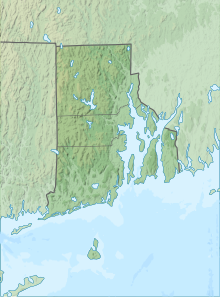
1676 (MDCLXXVI) was a leap year starting on Wednesday of the Gregorian calendar and a leap year starting on Saturday of the Julian calendar, the 1676th year of the Common Era (CE) and Anno Domini (AD) designations, the 676th year of the 2nd millennium, the 76th year of the 17th century, and the 7th year of the 1670s decade. As of the start of 1676, the Gregorian calendar was 10 days ahead of the Julian calendar, which remained in localized use until 1923.
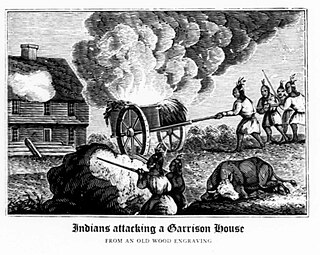
1675 (MDCLXXV) was a common year starting on Tuesday of the Gregorian calendar and a common year starting on Friday of the Julian calendar, the 1675th year of the Common Era (CE) and Anno Domini (AD) designations, the 675th year of the 2nd millennium, the 75th year of the 17th century, and the 6th year of the 1670s decade. As of the start of 1675, the Gregorian calendar was 10 days ahead of the Julian calendar, which remained in localized use until 1923.

Metacomet, also known as Pometacom, Metacom, and by his adopted English name King Philip, was sachem to the Wampanoag people and the second son of the sachem Massasoit. His older brother Wamsutta briefly became sachem after their father's death in 1661. However, Wamsutta also died shortly thereafter and Metacom became sachem in 1662.

King Philip's War was an armed conflict in 1675–1676 between a group of indigenous peoples of the Northeastern Woodlands and the English New England Colonies and their indigenous allies. The war is named for Metacomet, the Pokanoket chief and sachem of the Wampanoag who adopted the English name Philip because of the friendly relations between his father Massasoit and the Plymouth Colony. The war continued in the most northern reaches of New England until the signing of the Treaty of Casco Bay on April 12, 1678.
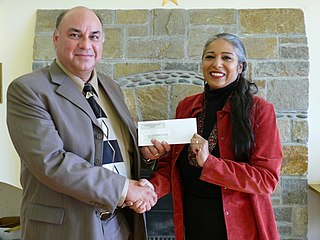
The Wampanoag, also rendered Wôpanâak, are a Native American people of the Northeastern Woodlands currently based in southeastern Massachusetts and formerly parts of eastern Rhode Island. Their historical territory includes the islands of Martha's Vineyard and Nantucket.

The Pequot War was an armed conflict that took place in 1636 and ended in 1638 in New England, between the Pequot tribe and an alliance of the colonists from the Massachusetts Bay, Plymouth, and Saybrook colonies and their allies from the Narragansett and Mohegan tribes. The war concluded with the decisive defeat of the Pequot. At the end, about 700 Pequots had been killed or taken into captivity. Hundreds of prisoners were sold into slavery to colonists in Bermuda or the West Indies; other survivors were dispersed as captives to the victorious tribes.

The Narragansett people are an Algonquian American Indian tribe from Rhode Island. Today, Narragansett people are enrolled in the federally recognized Narragansett Indian Tribe. They gained federal recognition in 1983.
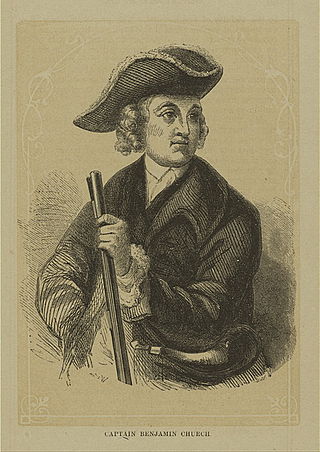
Colonel Benjamin Church was an New England military officer and politician who is best known for his role in developing military tactics and participating in numerous conflicts which involved the New England Colonies. He is also known for commanding one of the first ranger units in North America. Born in the Plymouth Colony, Church was commissioned by Governor Josiah Winslow to establish a company of rangers after the outbreak of King Philip's War in 1675. A force of New Englanders led by him was responsible for tracking down and killing Wampanoag sachem Metacomet, which played a major role in ending the conflict.

Weetamoo, also referred to as Weethao, Weetamoe, Wattimore, Namumpum, and Tatapanunum, was a Pocasset Wampanoag Native American Chief. She was the sunksqua, or female sachem, of Pocasset tribe, which occupied contemporary Tiverton, Rhode Island in 1620. The Pocasset, which she led, was one of groups of the Wampanoag.

Nine Men's Misery is a site in current day Cumberland, Rhode Island, where nine colonists were tortured by Narragansett warriors during King Philip's War. A stone memorial was constructed in 1676 and is believed to be the oldest war monument in the United States.

Smith's Castle, built in 1678, is a house museum at 55 Richard Smith Drive, near Wickford, a village in North Kingstown, Rhode Island. Smith's Castle is one of the oldest houses in the state. It was designated a National Historic Landmark in 1993 as Cocumscussoc Archeological Site due to the artifacts and information that digs have yielded in the area. It is located just off U.S. Route 1 in Rhode Island.
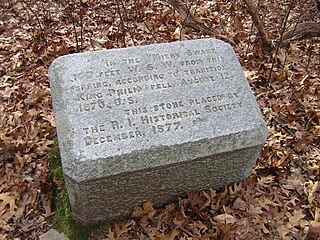
Mount Hope is a small hill in Bristol, Rhode Island overlooking the part of Narragansett Bay known as Mount Hope Bay. It is the highest point in Bristol County, RI. The 7000 acres that now make up the Town of Bristol in Rhode Island were called the Mt. Hope Lands. The elevation of Mt. Hope summit is 209 feet, and drops sharply to the bay on its eastern side. Mount Hope was the site of a Wampanoag (Pokanoket) village. It is remembered for its role in King Philip's War.
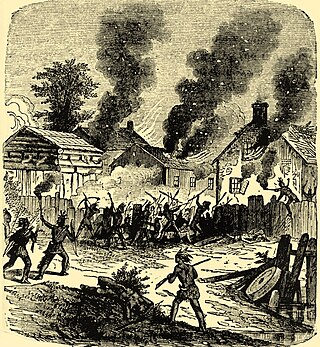
Wheeler's Surprise, and the ensuing Siege of Brookfield, was a battle between Nipmuc Indians under Muttawmp, and the English colonists of the Massachusetts Bay Colony under the command of Thomas Wheeler and Captain Edward Hutchinson, in August 1675 during King Philip's War. The battle consisted of an initial ambush by the Nipmucs on Wheeler's unsuspecting party, followed by an attack on Brookfield, Massachusetts, and the consequent besieging of the remains of the colonial force. While the place where the siege part of the battle took place has always been known, the location of the initial ambush was a subject of extensive controversy among historians in the late nineteenth century.

The Battle of Bloody Brook was fought on September 28, 1675 between an indigenous war party primarily composed of Pocumtuc warriors and other local indigenous people from the central Connecticut River valley, and the English colonial militia of the New England Confederation and their Mohegan allies during King Philip's War.
The siege of Springfield was a siege of the colonial New England settlement of Springfield by Native Americans during King Philip's War. Springfield was the second colonial settlement in New England to be burned to the ground during the war, following Providence Plantations. King Philip's War remains, per capita, the bloodiest war in American history.
Samuel Appleton was a military and government leader in the Massachusetts Bay Colony and Province of Massachusetts Bay. He was a commander of the Massachusetts militia during King Philip's War who led troops during the Attack on Hatfield, Massachusetts and the Great Swamp Fight. He also held numerous positions in government and was an opponent of Governor Sir Edmund Andros.

The Second Battle of Nipsachuck Battlefield is a historic military site in North Smithfield, Rhode Island. A largely swampy terrain, it is the site of one of the last battles of King Philip's War to be fought in southern New England, on July 2, 1676. The battle is of interest to military historians because it included a rare use in the war of a cavalry charge by the English colonists. The site was listed on the National Register of Historic Places in 2016.

Quaiapen was a Narragansett-Niantic female sachem (saunkskwa) who was the last sachem captured or killed during King Philip’s War.
Pumham was one of Metacomet's chief advisors during King Phillip's War. He was sachem of Shawomet. He was described as "one of the stoutest and most valiant sachems that belonged to the Narragansett." He was friends with English settlers, but aligned himself with Metacomet when war broke out.

Stonewall John was a seventeenth century Narragansett leader in Rhode Island who was a skilled stone mason and blacksmith often credited with building stone wall fortifications at Queen's Fort in Exeter and Stony Fort, and blockhouses at the Great Swamp Fort.

